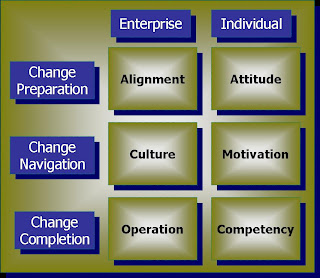
One of the frustrating aspects of consulting is when helping a client to develop a solution to a problem for which they have requested help, but then running into resistance from the client in making the necessary changes to implement the solution. Certainly much has been written on this topic including many activities for facilitating the change process. These activities, if you will pardon the metaphor, are much like medicine administered to treat organizational ailments.
We all know by now that you don't treat a virus with an antibiotic. Not only does that type of medicine not work against that type of illness, it leads to the efficacy of the medicine to be compromised as resistance to the drug is developed. I believe the same applies for activities utilized to manage organizational change. Different activities fit with different problems. Using the wrong one may not only result in no improvement to the change adoption, it may also cause members of the organization to shun or avoid this type of activity in the future. For example, I have seen many failed teambuilding activities drive teams to become avoidant toward future teambuilding exercises.
What I believe is requred to prevent the problem of administering inappropriate change management activities is to improve the understanding regarding the sources of change resistance. The source of resistance is similar to the cause of an illness. This is where the table presented in this entry comes into play.
We all know by now that you don't treat a virus with an antibiotic. Not only does that type of medicine not work against that type of illness, it leads to the efficacy of the medicine to be compromised as resistance to the drug is developed. I believe the same applies for activities utilized to manage organizational change. Different activities fit with different problems. Using the wrong one may not only result in no improvement to the change adoption, it may also cause members of the organization to shun or avoid this type of activity in the future. For example, I have seen many failed teambuilding activities drive teams to become avoidant toward future teambuilding exercises.
What I believe is requred to prevent the problem of administering inappropriate change management activities is to improve the understanding regarding the sources of change resistance. The source of resistance is similar to the cause of an illness. This is where the table presented in this entry comes into play.
The format of the table suggests that resistance can come from both the individual as well as the enterprise as a whole. Additionally, the table suggests that the nature of resistance changes as the stages of the change process progress - represented by preparation, navigation and completion. The result of the table format provides six sources of resistance, which then demand different types of change facilitation activities to overcome the resistance.
So, for example, if an organizational change is bumping up against the culture of the company different activities are required as compared to what is needed to overcome resistance due to problems with motivation, for instance. Let's use the introduction of salesforce automation as a specific example to illustrate this. Within many clients I have found that SFA is rejected because the culture of the sales organization has been traditionally undisciplined. If a sales rep beats his or her number, he or she gets away with a lot of rule breaking. The more the number is blown away, the more rules that can be broken. However, SFA not only requires for rules to be followed, it is typically implemented with additional rules. This is a clear conflict with the "cowboy" culture that characterizes many sales functions.
What do you do to address this form of resistance? Focusing on process changes (more typically associated with operational resistance sources) will probably not work. This is an issue of discipline and accountability. The change facilitation activity requires that the cultural norm of rule breaking be addressed. If on the other hand the issue is more oriented toward user motivation, then the activity must be more focused on finding a reason why adoption has a benefit for the user. If there is none, the resistance will continue so the best remedy is to design a motivating benefit into the system.
So, in summary, I believe it is very critical for those who introduce and manage change facilitation activities to have a strong understanding of the sources of resistance. These are the causes of change adoption problems and require tailored solutions that fit the cause. The better the change facilitation activity fits the source of resistance, the greater the likelihood of getting that horse to drink.
This blog entry only introduces the concept of resistance sources. Much more can be written and shared regarding the nature of these six sources and even more regarding the change activities needed to overcome them. I hope you will share your experiences.